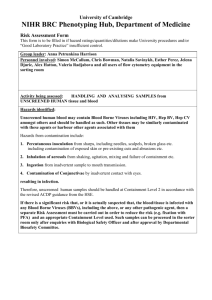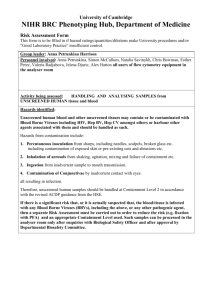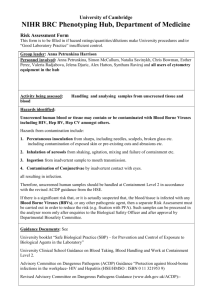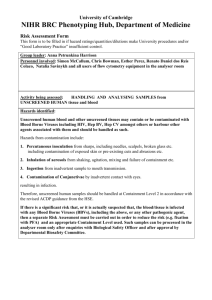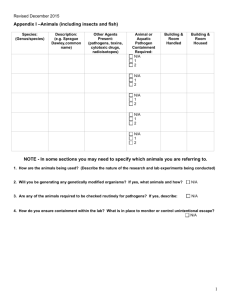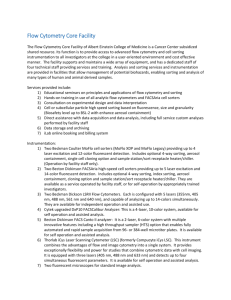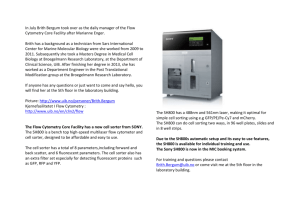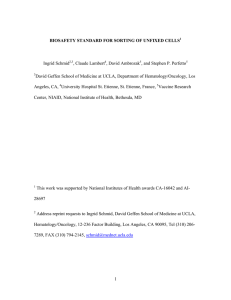Department of Medicine - University of Cambridge
advertisement
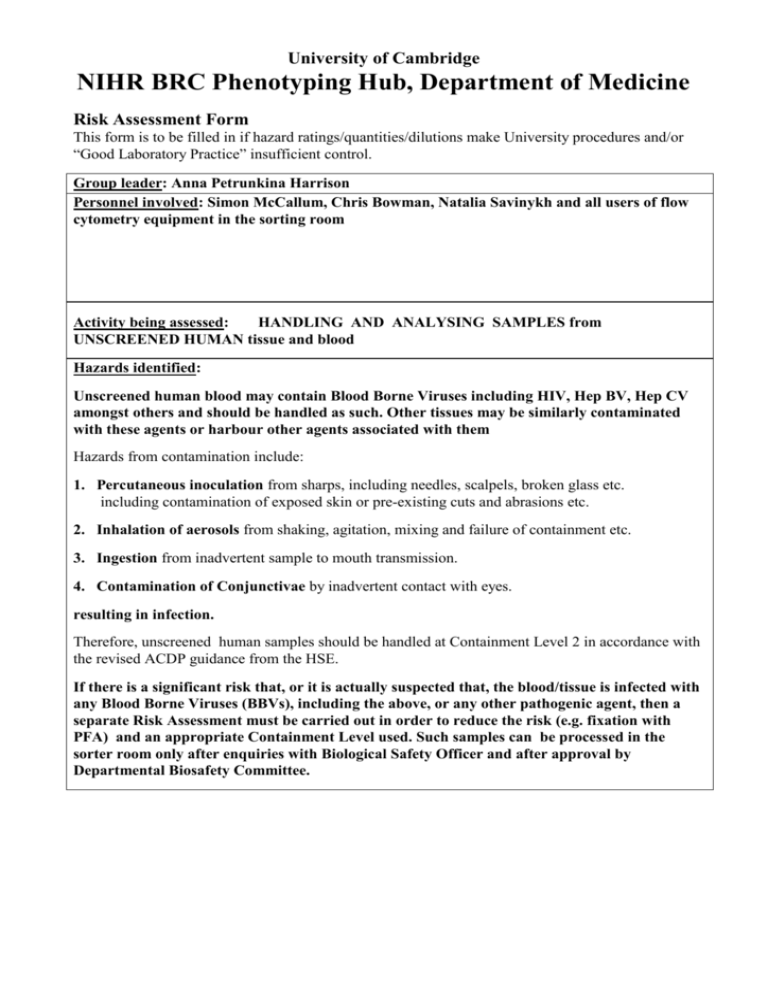
University of Cambridge NIHR BRC Phenotyping Hub, Department of Medicine Risk Assessment Form This form is to be filled in if hazard ratings/quantities/dilutions make University procedures and/or “Good Laboratory Practice” insufficient control. Group leader: Anna Petrunkina Harrison Personnel involved: Simon McCallum, Chris Bowman, Natalia Savinykh and all users of flow cytometry equipment in the sorting room Activity being assessed: HANDLING AND ANALYSING SAMPLES from UNSCREENED HUMAN tissue and blood Hazards identified: Unscreened human blood may contain Blood Borne Viruses including HIV, Hep BV, Hep CV amongst others and should be handled as such. Other tissues may be similarly contaminated with these agents or harbour other agents associated with them Hazards from contamination include: 1. Percutaneous inoculation from sharps, including needles, scalpels, broken glass etc. including contamination of exposed skin or pre-existing cuts and abrasions etc. 2. Inhalation of aerosols from shaking, agitation, mixing and failure of containment etc. 3. Ingestion from inadvertent sample to mouth transmission. 4. Contamination of Conjunctivae by inadvertent contact with eyes. resulting in infection. Therefore, unscreened human samples should be handled at Containment Level 2 in accordance with the revised ACDP guidance from the HSE. If there is a significant risk that, or it is actually suspected that, the blood/tissue is infected with any Blood Borne Viruses (BBVs), including the above, or any other pathogenic agent, then a separate Risk Assessment must be carried out in order to reduce the risk (e.g. fixation with PFA) and an appropriate Containment Level used. Such samples can be processed in the sorter room only after enquiries with Biological Safety Officer and after approval by Departmental Biosafety Committee. Guidance Documents: See University booklet “Safe Biological Practice (SBP) – for Prevention and Control of Exposure to Biological Agents in the Laboratory” University Clinical School Guidance on Blood Taking, Blood Handling and Work at Containment Level 2. Advisory Committee on Dangerous Pathogens (ACDP) Guidance “Protection against blood-borne infections in the workplace- HIV and Hepatitis (HSE/HMSO : ISBN 0 11 321953 9) Revised Advisory Committee on Dangerous Pathogens Guidance (www.doh.gov.uk/ACDP):- Control measures to reduce the level of risk: Unscreened human samples processed for flow cytometry analysis should be handled at Containment Level 2. In addition to the measures and facilities normally specified for work at Containment Level 2 (see relevant guidance), the additional measures listed below should also apply when, as here, Containment Level 2 is specified. These extra precautions should be in constant use to guard against percutaneous inoculation, contamination of the skin, conjunctivae, mucous membranes and the working surfaces. • All work must be conducted in a designated containment level 2 work area (Phenotyping Hub sorting lab space) with sufficient space to work safely. The whole sorting room with exception of specially designated office area on the left-hand and right hand side is Containment Level 2 space – these are not to be used for or exposed to samples. • Access to CL2 areas is restricted to authorised staff ONLY, in order to ensure that the person(s) conducting the work is(are) free from the risk of disturbance or accidental contact with others.. Only trained cytometry operators are authorised to work in the sorting room unsupervised. All users are advised that the sorter room is CL2 workspace, and on the necessity to adhere to procedures relevant for handling their own samples and to perform risk assessment for their own experiments. This advice is now incorporated in the training for flow cytometry area. • The use of sharps and glassware must be avoided in the and Sorting lab. Where such use is essential, particular care must be taken in their handling and disposal after contact with unfixed materials, and any exception can be only subsequent to the application and review of the RA for the protocols. • Lesions on exposed skin should be covered with waterproof dressings. • Protective clothing must include an appropriate laboratory gown, disposable gloves and other personal protective equipment appropriate to the task, including eye protection when appropriate. The need for wearing eye protection will be specified in the particular project Risk Assessment prepared by the investigators in consultation with flow cytometry unit, and after approval by the Biosafety Committee. • The workstations must be kept clear of unnecessary equipment and not used for storage. • When operating a sorter etcr, samples must be handled with care, especially when taking them off the injection port and when a blockage has occured. There is a risk of aerosol generation form the sorting equipment. . Sorter is placed into MSC thereby containing the aerosols. The MSC is serviced once a year by contractor. It is a contractor responsibility to calibrate the MSC or otherwise monitor that the settings are appropriate to ensure adequate level of biocontainment. Fumigation of the cabinet is done by a contractor according to an approved SOP and in accordance with the local Rules. All prospective users must fill out and sign a FACS Biosafety assessment sheet for batches of similar sort within a project. The biosafety sheet is signed off by Flow Cytometry and Imaging Officer Simon McCallum, or, in his absence by trained core staff. Only qualified sorter operators (Hub core staff) can make decision on whether to process the samples for sorting and only they can operate sorters. Any obviously CL 1 or 2 material can be sorted without delay. All other applications must be sent for assessment/discussion to the Biological Safety Officer Mark Wills. Dr. Mark Wills will assess whether the risk assessment for experiments is adequate, in particular, whether the risk has been sufficiently reduced by additional procedures and factors (e.g. additional training, special handling procedures which are adequate for each particular project etc) and refer to the Safety Committee in cases of enhanced risk. In situation where the residual risk is still considered to be above CL2 levels, and an approval of Safety Committee cannot be obtained, samples cannot be processed. The bench surface and any equipment must be disinfected immediately after completion of work. Following disinfection policy is in operation: 1) After completion of flow cytometry work, sorter injection tube must be cleaned as described in the guidance notes by the manufactuer . The waste tank needs to be supplemented with Trigene in the quantity prescribed for each particular instruments (final concentration of 10%). NOTE: Virkon must be never used for cleaning sorting equipment injection port or any other parts due to risk of corrosion! 2) In case of spillages, surface area has to be sprayed with Trigene and wiped. • For all operating staff of the Hub conducting work on the sorter, Hep BV vaccine, together with follow-up procedures, is a requirement. • Contaminated waste will be disposed of in accordance with local guidance and rules for the safe disposal of Containment Level 2 waste; including chemical sterilisation of liquids with autoclaving and incinerating for solids as appropriate. Level of risk remaining: Residual risk of percutaneous inoculation; which must be minimised by the avoidance of sharps. Residual risk of splashes in eyes; which must be minimised by use of suitable eye protection. Emergency procedures: NB: See Guidance Documents as above. First Aid: Wash any contaminated skin, conjunctivae or mucous membrane immediately. In the event of a wound, it should be allowed to bleed by irrigation under running water. Seek medical Advice and contact University Occupational Health Service immediately. Spillage: All spillages and surface contamination must be immediately cleaned up and removed including decontamination with a suitable validated disinfectant (10% solution of Trigene). Blockages of the AriaIII: When the AriaIII is blocked, there may be a generation of infective aerosol. The waste drawer and stream should be shut off and the sort chamber opened after checking that the hood still functions. The system should then be left for 5min for any aerosol to evacuate, before spraying the chamber and all other relevant parts/surfaces with 70% Ethanol (gloves must be worn) and attempting repair. Only core staff will deal with the blockage. Major spillages and leaks (resulting in significant surface being covered with fluid, more than 100 ml) should be reported to core manager Simon MCCallum who will assess the incident, keep the record of it and report it to biosafety officer if appropriate. Name and status of assessor: Anna Petrunkina, Director of the Cell Phenotyping Hub Date of assessment: 1/09/13 Signature of assessor: Revision due date: 1/09/14
